|
|
|
About Slovaks and Slovak Immigration |
The Slovaks in AmericaHelen Fedor, Table of ContentsChronology1695Isaac Ferdinand Sarosi (also spelled Sarissky, Scharossy, Saarossy, Sarossy, Saroschi, and Sarossi) was the first known immigrant from what is now Slovakia; it is not clear what his mother tongue was. Sarosi arrived in the Pennsylvania religious colony of Germantown (originally Germanopolis), founded by Mennonite preacher Francis Daniel Pastorius, to serve as a teacher and a preacher. Sarosi returned to Europe after two years. 1754Andrej Jelik fled Slovakia to escape military conscription. After much travel in Europe, he eventually reached American shores, via the West Indies, on a Dutch trading ship. 1775After being proclaimed emperor in Madagascar, and bearing letters of recommendation from Benjamin Franklin and funds from a descendant of Ferdinand Magellan, (Matus) Moric Benovsky came to America and fought with American troops in the War for Independence. He joined a cavalry corps led by General Pulaski and fought in the siege of Savannah. He died in Madagascar in 1786, but his wife, Zuzana Honschova, spent the years from 1784 until her death in 1815 in the United States. 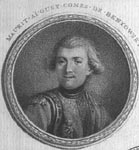
A portrait of Benovsky, from the title page of a 1790 English translation of his memoirs 1780Major Jan Polerecky, who trained at the French Royal Military Academy of St. Cyr, came to America from France to fight with George Washington's army in the War for Independence. He was in the company of the 300 "Blue Hussars" to whom the British formally surrendered their weapons after the defeat of Cornwallis at Yorktown. When the war was over, Polerecky settled in Dresden, Maine, where he served in a number of public positions. 1861President Abraham Lincoln approved a request to organize a military company named the "Lincoln Riflemen of Sclavonic [Slavic] Origin." This first volunteer unit from Chicago, which included many Slovaks, fought in the Civil War and was eventually incorporated into the 24th regiment of the Illinois infantry. 1868(Frantisek) Samuel Figuli received his first papers for naturalization. Figuli fought in the Civil War, owned a plantation in Virginia, and later joined an exploratory expedition to the North Pole. 1873A cholera epidemic and subsequent widespread crop failures set in motion large-scale emigration from the eastern regions of Slovakia. This wave of emigration was also fueled by hardships connected to the coming of industrialization, the scarcity of available land, and a campaign of forced magyarization. The immigrants were predominantly men coming to find work. 1877Daniel Sustek, a world traveler, purchased some eighty acres of land in Iowa, where he hoped to develop a Slovak colony.
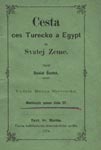
Cesta ces Turecko a Egypt do Svatej Zeme (The road through Turkey and Egypt to the Holy Land), an 1874 travel booklet written by Daniel Sustek. The booklet was published by Matica slovenska, the Slovak national cultural institution, in what was then Hungary. 1879Slovaks in Passaic, New Jersey, welcomed the first group of women who came to their community from Slovakia. When Hungarian authorities legislated that all men under the age of 50 must remain in the country to fulfill military service, the number of women emigrating increased markedly. 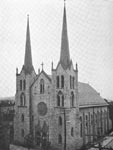
St. Mary's Assumption Roman Catholic Slovak Church in Passaic, c.1920. The parish was founded in 1891, but ground for this building was not broken until 1904. 1883The first Slovak beneficial society was formed in New York when a group of Slovaks, mostly from the eastern counties of Slovakia, met in a private home and organized The First Hungarian-Slovak Sick Benefit Society. The society's by-laws contained the provision that the eastern Slovak dialect be used as long as there were seven members in the society. Beneficial societies were formed as insurance societies and unions, but they also played cultural, social, and political roles. 1886The first printed Slovak newspaper, the Amerikanszko-szlovenszke noviny (Amerikansko-slovenske noviny), was published by Jan Slovensky. Circulation reached 30,000 at the end of the century under editor Peter V. Rovnianek. This was a larger circulation than that of any other Slovak paper of the time, even in Slovakia. 1887The First Coopers' Beneficial Society was founded in Bayonne, New Jersey. It was the first Slovak society to uphold the interests of workers and even negotiated with factory owners.  A map of Bayonne, NJ, from All About Bayonne City, N.J., 1895. Americky tlumac (American interpreter), the first Slovak-English dictionary serving the needs of the immigrants, was published by Jan Slovensky, in an eastern dialect. It readily became very popular because it aided the immigrants with their English language problems. Several other such works were published in subsequent years. A page from Prakticny slovensko-anglicky tlumac. The Practical Slovak American (sic) Interpreter, compiled by Paul Kadak in 1905, showing useful phrases concerning work. 1889Anton S. Ambrose (Ambrosi), a journalist who never completed his high school studies, founded the newspaper Slovak v Amerike, the oldest Slovak newspaper still in print in the United States. The first Slovak school in America was established by St. Stephen's Parish in Streator, Illinois.

Lesson 16 from Prva citanka pre slovenske skoly v Amerike (First reader for Slovak schools in America), compiled by Reverend Stefan Furdek. 1890The First Catholic Slovak Union of America, Jednota, was founded in Cleveland, under a constitution drafted by the Reverend Stefan Furdek. The National Slovak Society (Narodny slovensky spolok) was founded in Pittsburgh by Peter V. Rovnianek. The society was the first supraregional, nondenominational association of Slovaks in the United States, and is still active today. 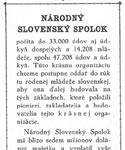
Membership recruiting brochure of the Narodny slovensky spolok (National Slovak Society). 1891About 18,000 Slovaks were among the miners who went on strike in the Connellsville, Pennsylvania, region, protesting exploitation and a cut in wages. Connellsville, Fayette County, Pennsylvania 1897. Drawn by T. M. Fowler. 1894The Slovak Colonization Society organized about 300 Slovaks to leave the labor-troubled region of Connellsville, Pennsylvania, and establish a Slovak colony in Arkansas, named Slovaktown. The society was organized by Peter V. Rovnianek and his associates. 1896The Slovak Gymnastic Union "Sokol" was founded in Chicago, modeled after the Czech "Sokol" gymnastic movement begun in Europe in the 19th century. Reverend Jozef Murgas, born in Tajov, Slovakia, came to America. He was active in founding several Slovak groups and was a pioneer of radiotelegraphy as well as a scholar, artist, scientist, and writer. He held twelve U.S. patents and was a signatory of the 1918 Pittsburgh Agreement. 1899-1915During this period, close to half a million Slovaks emigrated to the United States. 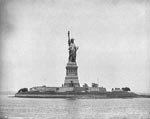
The Statue of Liberty in New York Harbor (July, 1905). This was the immigrants'
first view of America. It was a welcome sight for those who had undergone
a long, and often uncomfortable, journey across the ocean. The Registry Room at Ellis Island, New York (c. 1915). An immigrant's
first stop after leaving his or her ship was the Registry Room. Here, the
immigrant was inspected for medical, mental, and legal problems. This inspection
determined whether an immigrant would be detained or would receive permission
to land. 1901Peter V. Rovnianek launched Slovensky dennik, the first Slovak daily newspaper outside Slovakia and Hungary. 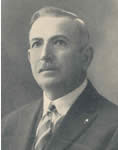 Photo of Peter V. Rovnianek from his autobiography Zapisky za živa pochoveného. 190552,368 Slovak immigrants arrived in the United States, making this the peak year of Slovak immigration. 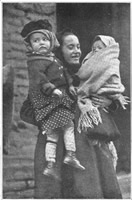 Newly arrived Slovak mother, from New Homes for Old, by Sophonisba Breckinridge, 1921 1907The Slovak League of America was formed to help prepare Slovak immigrants for American citizenship and to promote the welfare of Slovaks in the United States. 1910For the upcoming census, Slovak and other ethnic leaders in the United States sucessfully petitioned federal authorities to classify a person by his or her language rather than country of origin. On the president's orders, new forms replaced the old ones, and Slovaks were no longer classified as "Austrians" or "Hungarians" in the 1910 U.S. Census. 
"Accepted Names of Languages," from Thirteenth Census of the United States. Country of Birth and Mother Tongue. Instructions to Clerks.... 1914Stefan Banic, a Slovak inventor, constructed and tested a prototype of a parachute in Washington, D.C., by jumping from a 41-floor building and subsequently from an airplane. His patented parachute became standard equipment for U.S. pilots during World War I. Banic worked in the United States from 1907 to 1920, with two interruptions. 1915The leaders of the Czech National Alliance and the Slovak League of America signed the Cleveland Agreement, in which they pledged to cooperate for the common goal of independent statehood for the Czechs and Slovaks. The agreement's five articles laid out the basics of a future joint state for the two nationalities. Michal Bosak, once acclaimed as "the richest Slovak in America," founded the Bosak State Bank in Scranton, Pennsylvania. Bosak came to the U.S. in 1886 at age 16 and initially worked as a miner, going on to become a businessman whose ventures included the Bosak Manufacturing Company (a wine and liquor distribution business), the Bosak State Bank, a travel agency, and several financial institutions in northeastern Pennsylvania. Bosak was also a leader in the Slovak-American community, becoming a signatory to the Pittsburgh Agreement and the publisher of the weekly newspaper {Slovenska obrana}. All of Bosak's business and banking ventures ended during the Great Depression. The Bosak State Bank, from Scranton: Official Publication Scranton [sic] Chamber of Commerce, vol.3, no.3, November 1927, Scranton. Advertisement for Bosak's Horke Vino, a wine-based elixir produced and distributed by the Bosak Manufacturing Company, fromObrana: Narodny kalendar, Obrana Publishing Company, Scranton, 1922. 1918The Pittsburgh Agreement was concluded by representatives of Czechs and Slovaks at a meeting of the American branch of the Narodni rada ceskoslovenska (Czechoslovak National Council) in Pittsburgh. The agreement endorsed a program for the struggle for a common state of Czecho-Slovakia and agreed that the new state would be a democratic republic in which Slovakia would have its own administration, legislature, and courts. 1923Reverend Jaroslav Pelikan was born in Akron, Ohio. He is a Lutheran theologian and one of the leading church historians of the 20th century. 1933Michael Novak, a prolific Roman Catholic theologian and political writer, was born in Johnstown, Pennsylvania. In his works, he became a spokesman not only for Slovaks, but for all ethnic groups in the United States as well, in such works as Concepts of Ethnicity and Unmeltable Ethnics: Politics and Culture in American Life. 1941Out of This Furnace, the story of three generations of Slovaks working in steel mills, was published by Thomas Bell (Belejcak), an American-born writer who depicted the lives of Slovak immigrants in many of his works. 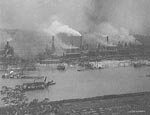
The Edgar Thomson Works, in Braddock, Pennsylvania (c. 1905). Many Slovak immigrant men worked at manual labor jobs, such as those in steel mills, coal mines, and foundries. Women most often either worked as domestic help or took in boarders at home. Courtesy: Prints and Photographs Division, Library of Congress, Washington, D.C. The 48-inch universal plate mill at the Homestead Steel Works, in Homestead,
Pennsylvania, (c. 1908). 1944The U.S. Navy commissioned the USS Durik, a warship named in honor of Joseph Edward Durik, a Slovak serviceman from Southwest, Pennsylvania, who had died as a result of an accidental torpedo firing on the USS Meredith. 1945Slovakia, which had been set up as an independent state by Nazi Germany, was reincorporated into Czechoslovakia. This led to an exodus of some 5,000 officials of the wartime Slovak Republic. 1948The take-over of Czechoslovakia by the communists spurred another wave of emigration. Many of these emigres were members of the intelligentsia and post-war political figures. 1953Jan Slezak, who had immigrated to the United States in 1914, was appointed Assistant Secretary of Defense. Slezak was trained as an engineer and spent much of his career in manufacturing, including the manufacture of armaments. His was the highest political position achieved by a Slovak outside of Slovakia. 1957Historian Viktor Mamatey published The United States and East Central Europe, for which he won the George Louis Beer Prize. Mamatey's father was Albert Mamatey, a signer of the Pittsburgh Agreement. 1958Two hundred intellectuals of Czech and Slovak origin founded the Czechoslovak Society of Arts and Sciences in America. 1961The Chicago Blackhawks professional hockey team won the Stanley Cup with the help of star center Stan Mikita, born in Sokolce, Slovakia, in 1940. During his career, Mikita won the Art Ross Trophy, the Hart Memorial Trophy (twice), the Lady Byng Trophy, and the Lester Patrick Trophy. 1966A Slovak room was established at the Immigration Archives of the University of Minnesota. 1968Another wave of Slovak immigration was fueled by the Soviet Union's invasion of Czechoslovakia, the Soviet response to the cultural and political liberalization of the Prague Spring. Many members of this wave belonged to the intelligentsia. Unlike earlier immigrants, they generally did not seek out Slovak immigrant groups. 1969Joseph M. Gaydos, born in Braddock, Pennsylvania, was elected to the U.S. House of Representatives, where he served for 24 years. He was the first Slovak-American to serve in the U. S. Congress. 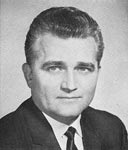
Congressman Joseph M. Gaydos, as he appeared in the Congressional Pictorial Directory, January 1969. 1970The Slovak World Congress was founded in New York. It became the leading organization of Slovaks living abroad, and represented associations, institutions, and individuals. 1972Astronaut Eugene A. Cernan was commander of the Apollo 17 lunar mission and the eleventh man to walk on the moon. Cernan was born in Chicago, in 1934, to a Czech mother and a Slovak father. After the end of the manned lunar missions, he acted as senior U.S. negotiator in discussions with the Soviet Union on the Apollo-Soyuz Test Project. 1976D. (Daniel) Carleton Gajdusek, born in 1923, in Yonkers, of a Slovak father and a Hungarian mother, won the Noble Prize for Physiology or Medicine together with Baruch S. Blumberg. The prize recognized his work on the causal agents of various degenerative neurological disorders. 1991A total of 1.8 million people identified themselves as being of Slovak ancestry in the 1990 U.S. Census. After Slovakia, this is the world's second largest concentration of people who are Slovak or of Slovak descent.
Selected BibliographyAlexander, June Granatir. The Immigrant Church and Community: Pittsburgh's Slovak Catholics and Lutherans, 1880-1915. Pittsburgh: University of Pittsburgh, 1987. Balch, Emily. Our Slavic Fellow Citizens. New York: Charitable Publication Co., 1910. Cincik, Joseph G. "A Study of Documents from Earliest Slovak-American Connections," Slovenske noviny, January 13, 1950. Culen, Konstantin. Slovaci v Amerike: crty z kulturnych dejin (The Slovaks in America: sketches of their cultural activities). Turciansky Sv. Martin: Matica slovenska, 1938. Krajsa, Joseph C., ed. Slovaks in America: A Bicentennial Study. Middletown, Pennsylvania: Slovak League of America, 1978. Miller, Kenneth D. The Czecho-Slovaks in America. New York: George H. Doran, 1922. Minar, Imrich. Americki slovaci a Slovensko: 1880-1980 (American Slovaks and Slovakia: 1880-1980). Bratislava: Bradlo, a.s., 1994. Pauco, Jozef. Slovenski priekopnici v Amerike (Slovak pioneers in America). Cleveland: Prva Katolicka slovenska jednota, 1972. Rechcigl, Miloslav, Jr. The Czechoslovak Contribution to World Culture. Hague: Mouton and Co., 1964. Rovnianek, Peter V. "The Slovaks in America," Slovakia, v. 17, no. 40, 1967. Slovakia. Matica slovenska. Slovensky biograficky slovnik: od roku 833 do roku 1990 (Slovak biographical dictionary: 833-1990). 6 v. Martin: 1986. Slovakia. Slovak Academy of Sciences. Encyclopedical Institute. Slovakia and the Slovaks. Bratislava: Goldpress Publishers, 1994. "The Slovaks Were There: Major John C. Polerecky Fought for America's Independence," Slovakia, v. 7, no. 3-4 (24-25), September-December 1957. Stasko, Joseph. Slovaks in the United States of America: Brief Sketches of Their History, National Heritage, and Activities. Cambridge, Ontario: Dobra Kniha, 1974. Stolarik, M. Mark. Growing up on the South Side: Three Generations of Slovaks in Bethlehem, Pennsylvania, 1880-1976. Lewisburg, PA: Bucknell University Press. London: Associated University Presses, 1985. Immigration and Urbanization: the Slovak Experience 1870-1918. New York: AMS Press, 1989. Tybor, M. Martina. The Slovaks in America to the End of the Nineteenth Century. Middletown, Pennsylvania: Jednota Printery, 1979. Yurchak, Peter P. The Slovaks: Their History and Traditions. Whiting, Indiana: Rev. John J. Lach, 1947.
Source:
European
Reading Room |